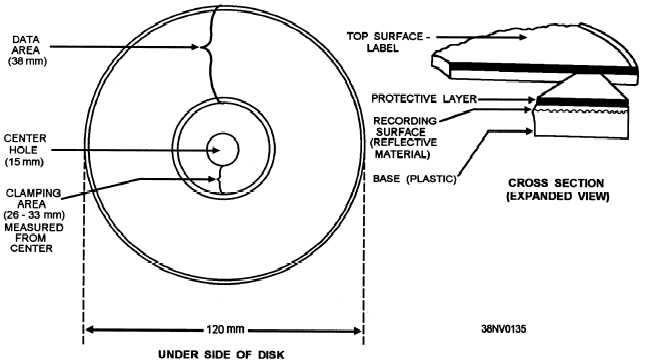PHYSICAL CHARACTERISTICS OF A
COMPACT DISC
The base of a CD is a clear, hard plastic, known as
polycarbonite. The CD is molded from a master that
forms the pits and lands. The top of the plastic disc is
coated with a reflective material, such as aluminum, that
reflects the light of the reading laser. The entire disc is
coated with a protective lacquer and a label is printed
on the top of the disc.
Figure 11-1 shows a typical compact disc. The
diameter of the disc is 120 mm. The center hole is 15
mm in diameter. The area closest to the center hole is
the clamping area, and no data is written in this area.
The clamping area is generally 26 mm to 33 mm wide,
measured from the center of the disc.
The data area is approximately 38 mm wide and is
divided into three sections. Figure 11-2 illustrates a
cross section of a CD-ROM’s data area. The table of
contents for the entire disc occupies the first 4 mm of
the data area. The next section is the program area, and
occupies 33 mm if the disc is filled to capacity. The
third area of the disc is the lead-out area and it is used
to tell the drive it has reached the end of the disc. No
data is written on the outer edge of the disc; this allows
for handling.
ADVANTAGES AND DISADVANTAGES
OF CD-ROM
CD-ROM has several advantages over magnetic
media in the dissemination of digital information. The
greatest advantage is the amount of data. A single
CD-ROM can store over 500 megabytes. The data on
a CD-ROM can also be a mixture of digital information.
The CD-ROM can store audio, video, graphics, text,
and programs. CD-ROMs that combine different types
of data (audio, graphics, and so on) are known as CD-I,
or compact disc-interactive.
The CD-ROM is extremely durable and difficult to
damage. Since the CD-ROM is an optical storage
medium, the read head never comes in contact with the
disc. Therefore, it does not suffer from damage caused
by head crashes as magnetic disk media do.
The CD-ROM does have disadvantages. Because
of the way the CD-ROM drive reads data, the access
time is much slower than for a high performance fixed
disk system. The CD-ROM is designed to hold a large
amount of data for a large number of users. The initial
high cost of producing the master disk precludes
sending unique information to just one or two users.
DATA STORAGE STRUCTURE
Information is written on a CD-ROM as a series of
pits and lands and read from the disk by detecting
reflections of a laser from the lands. When the laser
Figure 11-1.—A typical compact disc.
11-2


